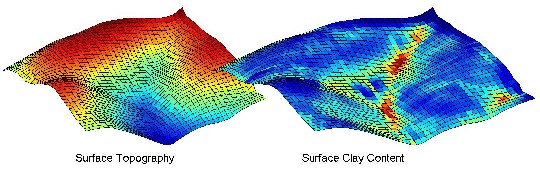

Background
The CREEP model simulates the sediment transport processes that fractionate
soil particles by texture into a soil catena. A soil catena is the cumulative
result of natural downslope interactions between pedogenic and geomorphic
processes, including drainage conditions, differential transport of eroded
material, and leaching, translocation, and redeposition of mobile chemical
constituents. Within a classically defined catena, finer particles, particularly
clays, are winnowed from the upper slopes and redeposited at the foot and
toe slopes by hillslope transport processes (e.g., Riecken and Poetsch, 1960).
Thus a catena implies both a lateral soil sequence and the geomorphological
and pedological processes instrumental to its formation.
We developed the CREEP model to track the evolution of surface transport
and the subsequent evolution of a soil profile. The model is diffusion-based;
as such it ignores event driven transport by specific rainfall events. Rather,
the decadal time step of the model presumes a time-averaging of surface transport
that, in gentle, vegetated landscapes can be assumed to be roughly proportional
to slope.
Sediment Transport
Sediment transport is simulated numerically as texturally dependent diffusive fluxes. Mass transport is parameterized by a linear diffusion model analog, transporting mass downslope in response to gradients in the local surface topography. However, CREEP differs from previous hillslope models by partitioning mass transport into texturally dependent diffusive fluxes where each textural component (sand/silt/clay) diffuses independently, responding to gradients in the local surface topography with a texturally dependent rate. To accomodate this textural dependence we take advantafge of the finite difference format found in the alternating direction implicit (ADI) numerical scheme but write separate differential equations for each texture component.
Isotopic Tracers
We introduced a stable isotope (10Be) to trace the movement of soil layers.
Using a conservative isotopic tracer allows us to observe the motion of surface
layers, and contrast this movement with the signature of soil carbon, which
has a more complex and transient soil residence history. 10Be
is introduced into the system through dust deposition. Once deposited,
it is assigned to the clay fraction, where it is assumed to advect downslope
by adhering to clay particles. Model-data comparisons require the addition
of an independent downhill transport mechanism of 10Be, in addition to that
assigned to the mineral fraction of eolian dust.
Code
http://sourceforge.net/projects/blitz/Because of the embedded Blitz++ array structures, CREEP is not currently configured to run under UNIX or Linux.
Dust Deposition:
Dust is deposited uniformly over the grid as a 'blanket' at each timestep.
The deposition rate is controlled by the user, and may vary through
time.
10Be Deposition:
The delivery of 10Be with the dust is also variable,
but assumed to be nearly constant at 2.2e8 atoms10Be / gDust.
Topography:
The landscape is classified as an ‘open’ system which is continually evolving and contains no unique or finite solution. As such, the model output is completely dependent on initial conditions, which are truly unknowable from the present landscape.Soil Carbon Dynamics/ Soil Decomposition (Jason Neff Algorithm)
Topographic rejuvenatio
Soil carbon dynamics are now simulated by CENTURY-4.0 based parameter estimates of total carbon production. These parameterizations will eventually be replaced by explicit estimation of multiple carbon pools by the Neff soil carbon model. The Neff soil decomposition algorithm implements a system of differential equations, associated utilities and an ODE solver to simulate the changes in carbon content and isotopic composition in various forms (pools) in soil. The soil structure evolved from two primary sources - Tom Hilinski's soil base class used in the implementation of erosion in the Century 5 ecosystem model, and Jason Neff's differential equations which quantify changes in content and composition of soil pools.
References
Riecken, F.F., and E. Poetsch (1960) Genesis and classification considerations of some prairie-formed soil profiles from local alluvium in Adair County, Iowa. Iowa Academy of Sciences. 67. p. 268-276.
Rosenbloom, N.A., S. C. Doney, and D. S. Schimel (2001) Geomorphic evolution of soil texture and organic matter in eroding landscapes. Global Biogeochemical Cycles. vol. 15, no. 2, p. 365-381.Rosenbloom, N.A., S. C. Doney and D. S. Schimel (1998) Hillslope mass transport, catenary sequences, and soil organic matter: Numerical simulations and model-data comparisons of the CREEP model for Great Plains grassland environments. Presented at the 1998 Fall Meeting of the American Geophysical Union. San Francisco, CA. December 1998. EOS Abstract. 79(45):F264.
Rosenbloom, N.A., R. McKeown and D. S. Schimel (1996) Predicting the interaction between long-term hillslope mass transport and vegetation dynamics. Presented at the 1996 Fall Meeting of the American Geophysical Union. San Francisco, CA. December 1996. EOS Abstract. 77(46):F253.
Rosenbloom, N.A. (1996) A model to predict the interactions between long-term hillslope mass transport and vegetation dynamics. Presented at the 1996 Fall Meeting of the Geological Society of America. Denver, CO. October 1996.
Rosenbloom, N.A., and R. S. Anderson (1994) Hillslope and channel evolution in a marine terraced landscape, Santa Cruz, California. Journal of Geophysical Research. 99. p. 14,013-14,029.